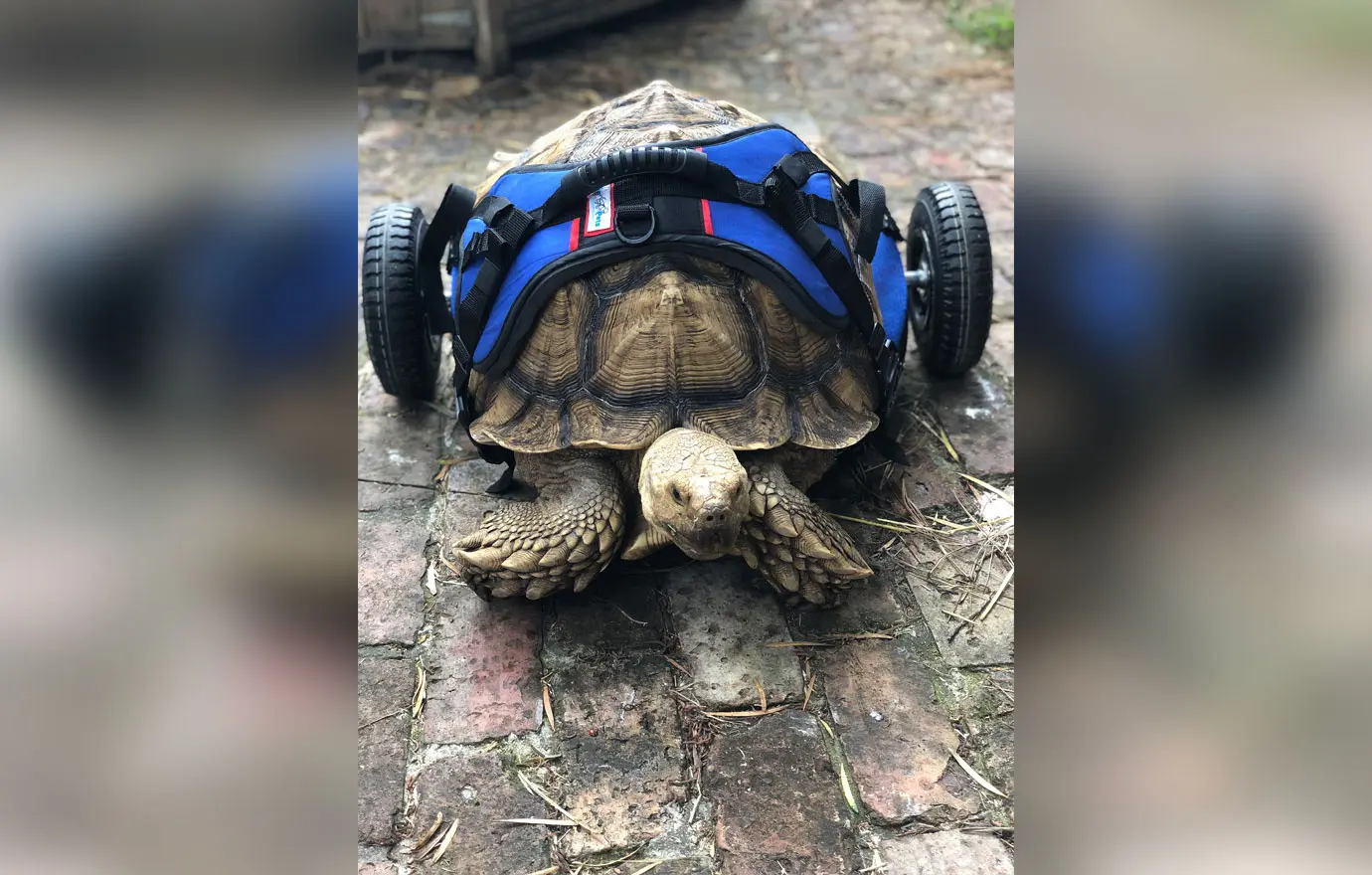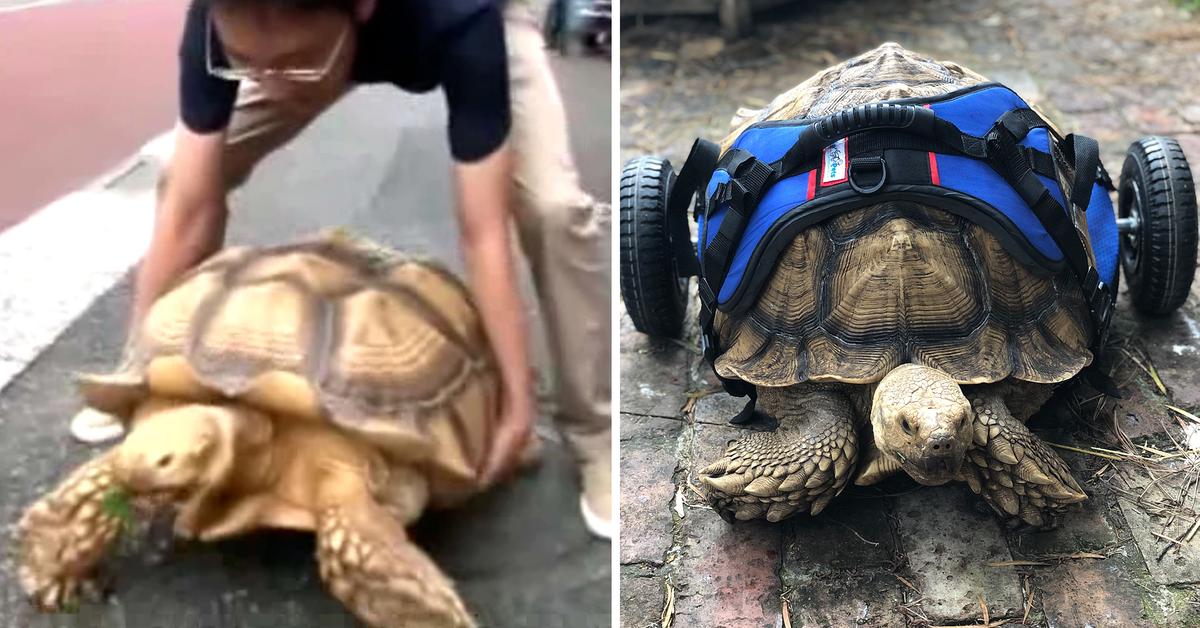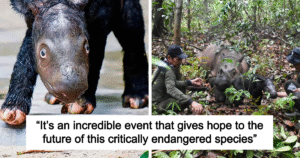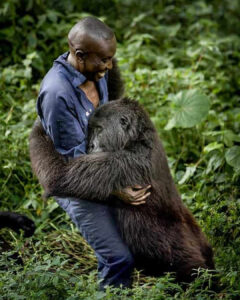A rescued tortoise named George Bailey can move again. For years, weak back legs made life hard. He had a metabolic bone disease that left his legs underdeveloped. He dragged his body to get around. That changed when his rescuer, Jaime Loebener, and a pet mobility team built a custom wheelchair. Now he is rolling forward and exploring his world like other animals—slow, steady, and proud.
Meet George Bailey
George is a Sulcata tortoise, also called an African spurred tortoise. At 11 years old, he already weighs about 70 pounds. Sulcatas are curious and friendly. Many people keep them as pets, but they grow very large. Some can reach over 200 pounds and live for many decades. As they get bigger, some owners realize they cannot give them the right space or care, so these tortoises end up in rescues or sanctuaries.
Loebener found George at an exotic animal facility in Knoxville, Tennessee. She saw his struggle and decided to help. The goal was simple: give George a safe, mobile life that respects his needs and his habitat.
Why movement matters to wildlife
Movement is not just about getting from one place to another. For wildlife, movement keeps the body strong. It helps with feeding, digestion, and mental health. A tortoise that cannot move well may not explore, graze, or soak up the sun the way it should. Over time, this can lead to stress and poor health. The wheelchair gives George freedom. It lets him do normal things again—browse for food, choose warm or cool spots, and interact with caretakers in a calm, natural way connected to nature.
The wheelchair design: simple, smart, and adjustable
The mobility team at Walkin’ Pets built a device made for a heavy shell and a unique body shape. A representative explained that the chair has a special base that can extend as George grows. The support is slightly rounded to match the curve of his shell. An adjustable harness keeps him secure without rubbing or pinching. The wheels are wide and stable, so he can move over smooth ground without tipping.
Tortoise shells and bodies are not like those of dogs or cats. A careful fit is critical. The frame must carry weight evenly. It must keep the shell balanced and let the front legs move freely. George uses his strong front legs to pull forward while the wheels help lift the back end. This reduces stress on weak limbs and prevents scrapes.

Food, water, and the right habitat
Sulcata tortoises are plant-eaters. George’s diet includes grasses, weeds, flowers, and cacti. Like other desert-adapted animals, Sulcatas can go long periods with little water. When they do find water, they drink a lot—sometimes up to 15% of their body weight. Good caretakers provide fresh water, safe grazing areas, and places to soak. They also avoid too many sugary fruits or soft greens. A smart diet supports bones and helps prevent shell and leg issues.
Just as important is the habitat. Sulcatas need space, strong fencing, and dry, warm shelters. They are powerful diggers and can damage yards if the setup is not thoughtful. A well-designed pen includes shade, a hide box, and safe flooring. Smooth concrete or packed soil works well with a wheelchair because it makes rolling easier and lowers the risk of falls.
Full Story: https://aquariumbee.com/man-loses-360-pounds-naturally-internet-rallies-to-support-his-next-step/
(Mid-article placement as requested.)
A day in George’s new life
With his wheelchair on, George moves around at his own pace. A short video shows him rolling across a patio. Each push with his front legs moves him forward. He looks calm and focused. Caretakers guide him to safe areas for sun time. They watch his skin, shell, and energy level. If he seems tired, they let him rest. The routine is simple but powerful: move, graze, rest, hydrate, repeat.
Over time, this daily pattern builds strength. Even short sessions can help the heart, lungs, and muscles. Motion supports digestion and keeps joints flexible. It also keeps George curious. He can choose where to go, which is a big mental boost for any living being.
Why some pet tortoises need extra help
Many people adopt Sulcatas when they are small and cute. Later, they learn how large and long-lived these tortoises are. Without enough space, sun, and proper diet, health problems can grow. Metabolic bone disease, like George had, is one result. It can happen when the body cannot build strong bones and shell. Common causes include poor lighting, lack of natural UVB exposure, and low calcium or imbalanced nutrition.
Rescues, vets, and mobility groups step in to help. They design wheelchairs, give medical care, and teach better husbandry. Education prevents problems. With the right setup, many tortoises thrive without needing special devices. For those that do, modern tools can be life-changing.
What caretakers can do better (simple checklist)
-
Plan for size and time. A Sulcata can live many decades and may top 100–200 pounds.
-
Provide sun or UVB lighting. Sunlight supports vitamin D3 and calcium use.
-
Feed a grass-based diet. Focus on weeds, grasses, and hardy plants; limit fruit.
-
Offer safe water and soaking. Hydration helps kidneys and digestion.
-
Create a sturdy habitat. Shade, wind protection, and strong fencing are essential.
-
Check feet and shell often. Look for sores from dragging or rubbing.
-
Work with a reptile vet. Regular checkups catch small issues early.
-
Consider mobility aids. If legs are weak, ask about braces or a cart.
A device that grows with the animal
George will likely need updates as he gets bigger. The current chair is built to extend and adjust. As weight changes, straps can be refit. Wheels can be swapped for different terrain. The goal is comfort and safety first. When a device fits well, the tortoise forgets it is there. It simply becomes part of the daily rhythm—much like a shoe you no longer notice.
Why this story matters for nature and wildlife
Stories like George’s do more than help one animal. They teach us to think about nature and wildlife with respect. Every species has special needs. When people learn those needs, fewer pets end up in trouble. The San Diego Zoo reminds us that small actions—saving water, not littering, using reusable bags—protect the wider environment. Keeping habitats clean and safe helps tortoises in captivity and those living in the wild.
Never release a pet into the wild. This is dangerous for the animal and for native wildlife. If you cannot keep a tortoise, contact a rescue or sanctuary. Responsible choices protect ecosystems and the animals that depend on them.
FAQs (clear and quick)
Q: How heavy can a Sulcata tortoise get?
A: Some reach over 200 pounds. Many homes are not prepared for that size, so plan ahead.
Q: Will a wheelchair hurt the shell?
A: A well-fitted cart supports the shell’s curve and avoids pressure points. Caretakers check pads and straps often.
Q: How long do Sulcatas live?
A: Many live for decades; some near a century. They are a lifelong commitment.
Q: Can a tortoise be happy with a wheelchair?
A: Yes. Mobility means choice—where to go, when to bask, what to explore. That freedom improves well-being.
Q: What surface is best for rolling?
A: Flat, stable ground like smooth concrete or hard-packed soil. Avoid steep slopes and loose gravel.
A hopeful ending
George’s journey shows what care, creativity, and patience can do. A custom wheelchair turned struggle into motion. With each push, he gains strength and confidence. He eats well, enjoys the sun, and takes in the world with calm eyes. This is what love for animals looks like in action: meeting real needs with smart, kind design.
If you are moved by George’s story, support your local rescue. Learn about proper tortoise care. Share good information with friends who love reptiles. One animal’s new life can inspire better care for many more.
Full Story:


